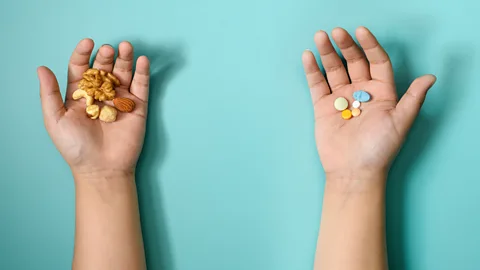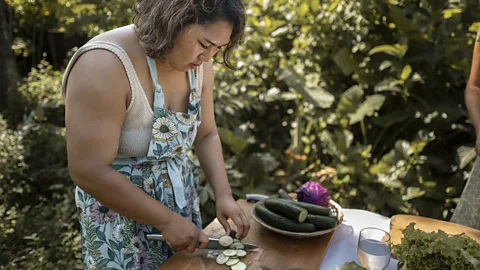
 Getty Images
Getty Images
Drugs like Ozempic have allowed many people to lose weight they were unable to shift before. Could a diet have the same effect without the need for a prescription?
The emergence of weight-loss drugs (agonists) including Ozempic and Wegovy has turned the medical world upside down in recent years.
Glucogen-like peptide 1 (GLP-1) agonists have proved effective in helping obese people lose weight by reducing the users' appetite, so they eat less. But alongside the hype, there have also been claims that we can easily mimic the drugs' effects with the foods we eat.
One social media trend, for example, suggests that drinking a concoction of oats blended with water and lime juice – nicknamed 'oatzempic' – acts as an appetite suppressant and helps people lose weight in the same way.
But can any diet or individual food or drink really come close to the effects of Ozempic? Can an "oatzempic" diet really work?
What are GLP-1 weight-loss drugs?
The new generation of weight-loss drugs mimic a process that naturally occurs in our bodies every day. When we eat, our guts produce the hormone GLP-1, which increases insulin levels in our blood, reduces the liver's sugar production, slows digestion and reduces appetite.
GLP-1 hormones are "master regulators" of our body's whole metabolic process, says Chris Damman, gastroenterologist and clinical associate professor at the University of Washington.
"These pathways are highly nuanced, involving many different hormones," he says.

 Getty Images
Getty Images
Can we mimic GLP-1 with diet?
The two main elements of our diet that are associated with GLP-1 are fibre and polyphenols.
"Fibre is the preferred food for the trillions of bacteria living in our gut," says Mary Sco, a resident physician and nutrition writer in Virginia in the US.
When we eat foods rich in fibre and polyphenol, these components are converted by our gut microbiome into short-chain fatty acids, which stimulate the production of GLP-1. Foods high in fibre include nuts, legumes, fruit and vegetables, while polyphenols can also be found in fruit, vegetables and nuts.
Naturally raising GLP-1 levels in the body isn't just about what we're eating – but also how we eat
Another important nutrient for metabolism is monounsaturated fat, which has also been associated with raised GLP-1. This can be found in olive oil, avocado and nuts.
This process also starts before food reaches our gut. Research shows that the bitter taste of polyphenol-rich foods triggers our taste receptors to send signals to the gut to produce digestive hormones including GLP-1.
Naturally raising GLP-1 levels in the body isn't just about what we're eating – but also how we eat, says Sco.
"There's emerging research showing that the order in which we eat also matters," she says.
Researchers write in a 2020 review that there is some research to suggest that eating foods high in protein, such as meat and eggs, and vegetables, before carbohydrates, leads to higher GLP-1 levels compared to eating carbs first. However, they say that the mechanisms behind this are largely unknown.

 Getty Images
Getty Images
The time of day you're eating may also make a difference to how much GLP-1 our bodies produce. There is some research to suggest that the body produces more GLP-1 when eating a meal early in the morning, compared to eating later in the evening.
This effect is linked to the natural changes to our hormone levels throughout the day, and eating early in the day supports the body's circadian rhythm, researchers wrote in the 2023 paper.
It would make sense, therefore, that eating a diet rich in fibre, polyphenols and monounsaturated fat would ensure we're producing lots of GLP-1. However, modern Western diets are currently lacking in the elements that produce the most GLP-1, says Damman.
"These weight-loss drugs are tapping into something fundamental in our satiety mechanism that's been short-circuited by modern ultra-processed foods," he says.
Do drugs or diets work better?
While for some people, a balanced diet and active lifestyle are enough to lose weight, for others, the GLP-1 agonists are necessary, Damman argues.
"It comes down to behaviour change, which is incredibly difficult. That's why lifestyle measures very often won't work for people caught in metabolic ruts, and why these drugs have been incredibly helpful for people with morbid obesity with complications."
Ultimately, a diet that encourages natural production of GLP-1 is full of whole foods, including fruit, vegetables, legumes and nuts
For others, eating a diet rich in fibre, polyphenols and monounsaturated fats can be an effective way to control our appetites, Sco says.
"Certain individuals might not have as large a benefit, but they will still get some. The rules apply to everyone because it's basic human physiology – we all get the 'stop-eating' signal."
Ultimately, a diet that encourages natural production of GLP-1 diet is full of whole foods, including fruit, vegetables, legumes and nuts, says Damman. That people could be discovering this by attempting to mimic the effects of weight-loss drugs is an irony not lost on some nutritional scientists, including Damman.
"The journey has come full-circle," he says. "All roads lead back to eating whole foods – there's no substitute for them."
The future of GLP-1 research
While we know prescribed GLP-1 agonists are generally considered safe, there's a lot we still don't know about them, says Damman.
But there is an emerging area of research that the weight-loss drugs are giving way to, which might help to better understand how to treat obesity, says Gary Schwartz, professor of medicine, neuroscience, and psychiatry and behavioural sciences at Albert Einstein College of Medicine in New York.
The reasons for rising rates of obesity in many parts of the world are numerous and complex, but many researchers agree that our food environment and modern lives are one part of the driving force.
Schwartz says that our food environment has only come to pose a threat relatively recently in human life, thanks to high-sugar, high-fat ultra-processed foods that maximise the components of food we're biologically wired to seek out.
When we consume these foods, the reward areas in our brain are activated with hits of dopamine, which means we overeat them. This, Schwartz says, can reduce our sensitivity to those components over time, so that we have to consume more and more to achieve the same level of sensory satisfaction.
More like this:
• Should we all be taking vitamin supplements?
• Is breakfast the most important meeting of the day?
But emerging data suggests that these drugs reduce people's desire to eat these palatable foods, over and above the side-effects of nausea and other GI symptoms people can experience while taking them, Schwartz says.
"These findings suggest that there's some kind of mechanism we can tap into to restore healthy eating without drugs by limiting the sense of reward and achieving a sense of satisfaction without overeating," he says.
Researchers could look at brain activity and behaviour during eating, weight loss and regain, Schwartz says, to see if there are any dietary and exercise interventions that can have similar effects.
"It will take clinical or dietary trials in conjunction with imaging and maintained weight loss, but within a decade, people will have an idea of certain hotspots in the brain and how to target them with behaviour or diet," Schwartz says.
--
For trusted insights into better health and wellbeing rooted in science, sign up to the Health Fix newsletter, while The Essential List delivers a handpicked selection of features and insights.
For more science, technology, environment and health stories from the BBC, follow us on Facebook and Instagram.
.png)


